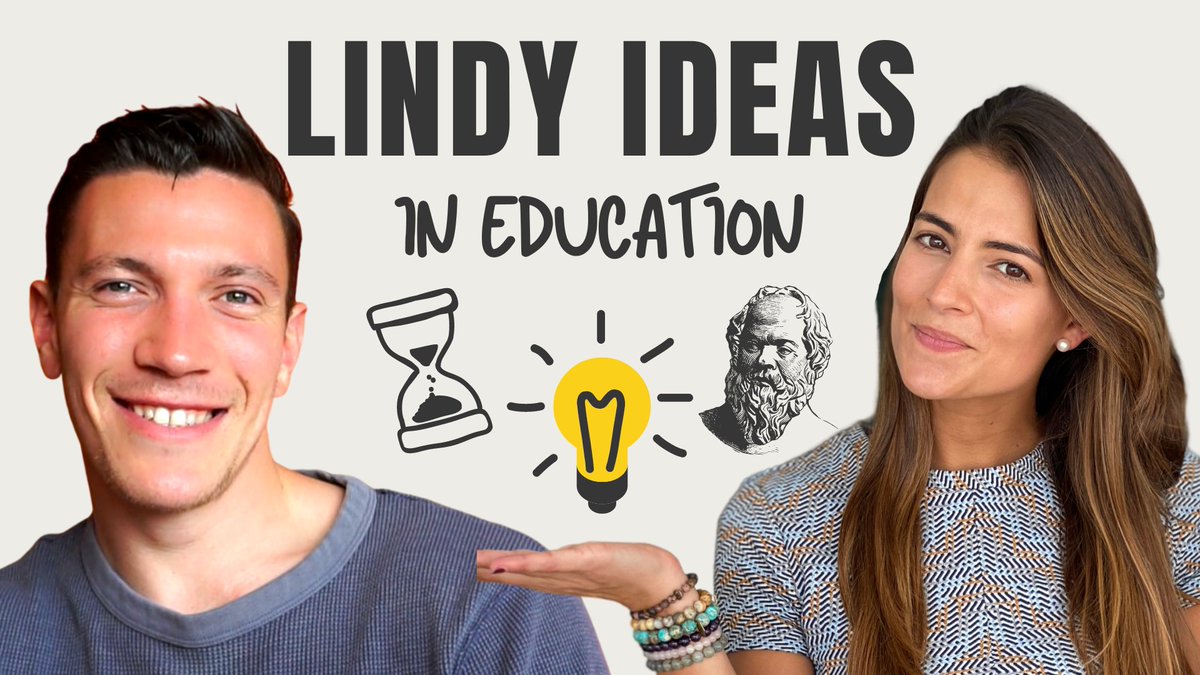I recently learned about the Lindy Effect.
This term, most recently studied by @nntaleb, states that the longer an idea has been around, the longer it is likely to stick around in the future.
What are some Lindy ideas in education?
A thread

This term, most recently studied by @nntaleb, states that the longer an idea has been around, the longer it is likely to stick around in the future.
What are some Lindy ideas in education?
A thread


Human life expectancy declines with age.
The Lindy Effect suggests that for ideas, it's the opposite: age = quality.
Here are 5 ideas in education that have stood the test of time:
The Lindy Effect suggests that for ideas, it's the opposite: age = quality.
Here are 5 ideas in education that have stood the test of time:
1/ Learning by doing is Lindy.
So is learning by mimicry and play.
In preliterate hunter-gatherer societies, parents taught their kids the basic survival skills by practicing them themselves, and whenever possible, inserting an element of play in the process.
So is learning by mimicry and play.

In preliterate hunter-gatherer societies, parents taught their kids the basic survival skills by practicing them themselves, and whenever possible, inserting an element of play in the process.
2/ The Socratic Method is Lindy.
It goes back 25 centuries.
With the Socratic Method, students lead the discussion and questioning. The teacher's role is to ensure the discussion advances regardless of the particular direction the discussion takes.
It goes back 25 centuries.

With the Socratic Method, students lead the discussion and questioning. The teacher's role is to ensure the discussion advances regardless of the particular direction the discussion takes.
3/Teaching through entertainment is Lindy.
Enforcing learning is *not* Lindy.
Back in the 5th century BC, the goal was to engage, impress, and entertain pupils using philosophy and rhetoric.
“Education is the kindling of a flame, not the filling of a vessel.” — Socrates
Enforcing learning is *not* Lindy.
Back in the 5th century BC, the goal was to engage, impress, and entertain pupils using philosophy and rhetoric.
“Education is the kindling of a flame, not the filling of a vessel.” — Socrates
4/ The teacher as a facilitator is Lindy.
“I cannot teach anybody anything. I can only make them think”― Socrates
Rather than conveying knowledge, teachers back then facilitated questions and dialogue until students arrived at their own understanding.
“I cannot teach anybody anything. I can only make them think”― Socrates
Rather than conveying knowledge, teachers back then facilitated questions and dialogue until students arrived at their own understanding.
5/ One-room schoolhouses are Lindy.
In the 18th and 19th centuries, many kids attended one-room schoolhouses where they learned in small, mixed aged groups.
Microschools are the reinvention of one-room schoolhouses. I explain microschools here:
In the 18th and 19th centuries, many kids attended one-room schoolhouses where they learned in small, mixed aged groups.
Microschools are the reinvention of one-room schoolhouses. I explain microschools here:
I expand on these Lindy ideas in this week’s Show&Tell episode with @david_perell:
We explore how education has evolved over the past 25 centuries and use the Lindy Effect to predict what educational practices are likely to stick around for the long run.
We explore how education has evolved over the past 25 centuries and use the Lindy Effect to predict what educational practices are likely to stick around for the long run.
You can listen to this episode on Spotify: https://spoti.fi/2RiTA02
H/t to @chrismanfrank for sparking this idea https://twitter.com/chrismanfrank/status/1274914855711956993
https://twitter.com/chrismanfrank/status/1274914855711956993
 https://twitter.com/chrismanfrank/status/1274914855711956993
https://twitter.com/chrismanfrank/status/1274914855711956993

 Read on Twitter
Read on Twitter


